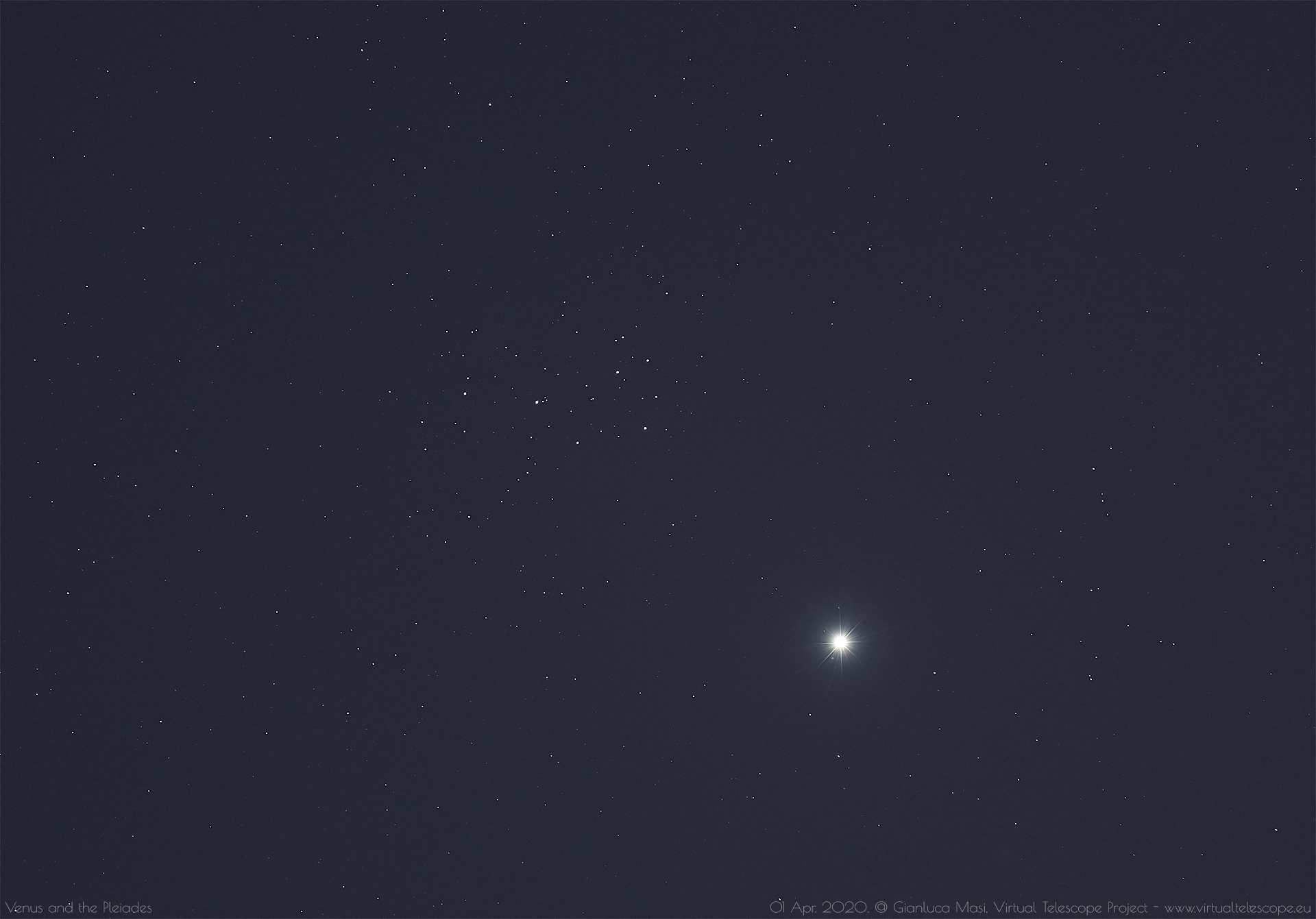
The coronavirus pandemic may have restricted our movements, but our eyes and minds can still roam the heavens. And there's a great reason to look up over the next few evenings.
Venus and the Pleiades star cluster, commonly known as the Seven Sisters, have come together in a dramatic conjunction that occurs just once every eight years. That conjunction will peak Friday evening (April 3), when Venus and the Pleiades star Alcyone will be separated by a mere 0.25 degrees. (For perspective: your clenched fist held at arm's length covers about 10 degrees.)
Look in the western sky after sunset; bright Venus will be very hard to miss.
"Venus's glare will practically overwhelm the cluster for naked-eye observers when it is closest, but binoculars and wide-field telescopes will show both the planet and the cluster beautifully," Space.com skywatching columnist Joe Rao wrote Thursday (April 2) in a story about how to observe Venus this month.
Venus and the Pleiades have conjunctions every year, but these extra-close ones are special; they occur every eight years, always in early April. And these sky shows will keep getting better and better over the next few decades, according to Rao.
"As Venus continues to pass a little farther north, it will actually go right through the main Pleiades stars in the years 2028, 2036, 2044 and 2052," he wrote in Thursday's story.
That's some small consolation for the folks who miss the current conjunction. But don't let that be you! On Friday evening, pause "Joe Exotic," or whatever show you're binge-watching, go outside and soak up this rare celestial spectacle.
Get the Space.com Newsletter
Breaking space news, the latest updates on rocket launches, skywatching events and more!
And, in case you're clouded out or otherwise thwarted from seeing the conjunction firsthand, the online Virtual Telescope Project will provide a live webcast Friday, starting at 1:30 p.m. EDT (1730 GMT).
- Examining the phases of Venus
- The brightest planets in April's night sky: How to see them (and when)
- What is a 'morning star,' and what is an 'evening star'?
Mike Wall is the author of "Out There" (Grand Central Publishing, 2018; illustrated by Karl Tate), a book about the search for alien life. Follow him on Twitter @michaeldwall. Follow us on Twitter @Spacedotcom or Facebook.
OFFER: Save at least 56% with our latest magazine deal!
All About Space magazine takes you on an awe-inspiring journey through our solar system and beyond, from the amazing technology and spacecraft that enables humanity to venture into orbit, to the complexities of space science.
Join our Space Forums to keep talking space on the latest missions, night sky and more! And if you have a news tip, correction or comment, let us know at: community@space.com.

Michael Wall is a Senior Space Writer with Space.com and joined the team in 2010. He primarily covers exoplanets, spaceflight and military space, but has been known to dabble in the space art beat. His book about the search for alien life, "Out There," was published on Nov. 13, 2018. Before becoming a science writer, Michael worked as a herpetologist and wildlife biologist. He has a Ph.D. in evolutionary biology from the University of Sydney, Australia, a bachelor's degree from the University of Arizona, and a graduate certificate in science writing from the University of California, Santa Cruz. To find out what his latest project is, you can follow Michael on Twitter.
-
rod I posted a note yesterday on my Venus and Pleiades observations using the telescope and binoculars at this article, https://forums.space.com/threads/april-is-the-month-of-venus-see-the-evening-star-at-its-brightest.30321/#post-514624Reply
Last night when I viewed, Venus and M45 (Pleiades) were about 54 arcminute angular separation, tonight much closer as space.com report shows. My location this evening calls for more clouds later but presently, lovely sunny sky :) I find my telescope observations and stargazing log entries can cause consternation for flat earth community folks when they find out what I see and post vs. their videos or astronomical teachings :). In early morning skies I track and view Mars, Jupiter, Saturn, during the day, observations of sunspot AR2759 that emerged on 30-March (reported at spaceweather.com), and Venus, Pleiades observations in the evenings. Time well spent and enjoyable outdoors--Rod










